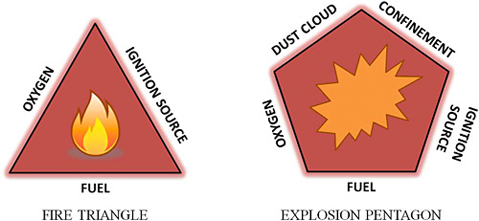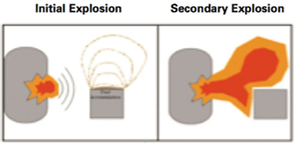
Give Us A Call: 713-229-9800 or 866-583-7774
Air Cleaning Solutions can help inform you how to protect your Company and Facility from Combustible Dust Explosions
Hazard Alert: Combustible Dust Explosions
Is your company or firm at risk of a combustible dust explosion? Combustible dusts are fine particles that present an explosion hazard when suspended in air in certain conditions. A dust explosion can cause injuries and death to employees as well as destruction of entire buildings. In many cases in which a combustible dust explosion occurred, employers and employees were unaware that a hazard even existed. It’s important to know what a combustible dust explosion is, what can cause it, and how to prevent it.
Is your company or firm at risk of a combustible dust explosion? Combustible dusts are fine particles that present an explosion hazard when suspended in air in certain conditions. A dust explosion can cause injuries and death to employees as well as destruction of entire buildings. In many cases in which a combustible dust explosion occurred, employers and employees were unaware that a hazard even existed. It’s important to know what a combustible dust explosion is, what can cause it, and how to prevent it.
 How Dust Explosions Occur
How Dust Explosions OccurIn addition to the familiar fire triangle of oxygen, heat, and fuel (the dust), dispersion of dust particles in sufficient quantity and concentration can cause rapid combustion known as a deflagration. If the event is confined by an enclosure such as a building, room, vessel, or process equipment, the resulting rise in pressure may cause an explosion. These five factors (oxygen, heat, fuel, dispersion, and confinement) are known as the “Dust Explosion Pentagon”. If one element of the pentagon is missing, an explosion cannot occur.

Catastrophic Secondary Explosions
An initial (primary) explosion in processing equipment or in an area where fugitive dust has accumulated may dislodge more accumulated dust into the air, or damage a containment system (such as a duct, vessel, or collector). As a result, if ignited, the additional dust dispersed into the air may cause one or more secondary explosions. These can be far more destructive than a primary explosion due to the increased quantity and concentration of dispersed combustible dust. Many deaths in past incidents, as well as other damage, have been caused by secondary explosions.
An initial (primary) explosion in processing equipment or in an area where fugitive dust has accumulated may dislodge more accumulated dust into the air, or damage a containment system (such as a duct, vessel, or collector). As a result, if ignited, the additional dust dispersed into the air may cause one or more secondary explosions. These can be far more destructive than a primary explosion due to the increased quantity and concentration of dispersed combustible dust. Many deaths in past incidents, as well as other damage, have been caused by secondary explosions.
Industries at Risk
Combustible dust explosion hazards exist in a variety of industries, including: agriculture, chemicals, food (e.g., candy, sugar, spice, starch, flour, feed), grain, fertilizer, tobacco, plastics, wood, forest, paper, pulp, rubber, furniture, textiles, pesticides, pharmaceuticals, tire and rubber manufacturing, dyes, coal, metal processing (e.g., aluminum, chromium, iron, magnesium, and zinc), recycling operations, fossil fuel power generation (coal), and 3D welding (a form of 3D printing). Click here for a more detailed list of materials that could present a combustible dust explosion hazard.
Combustible dust explosion hazards exist in a variety of industries, including: agriculture, chemicals, food (e.g., candy, sugar, spice, starch, flour, feed), grain, fertilizer, tobacco, plastics, wood, forest, paper, pulp, rubber, furniture, textiles, pesticides, pharmaceuticals, tire and rubber manufacturing, dyes, coal, metal processing (e.g., aluminum, chromium, iron, magnesium, and zinc), recycling operations, fossil fuel power generation (coal), and 3D welding (a form of 3D printing). Click here for a more detailed list of materials that could present a combustible dust explosion hazard.

Prevention of Dust Explosions
To identify factors that may contribute to an explosion, OSHA recommends a thorough hazard assessment of:
To identify factors that may contribute to an explosion, OSHA recommends a thorough hazard assessment of:
- All materials handled;
- All operations conducted, including by-products;
- All spaces (including hidden ones); and
- All potential ignition sources.
Why Air Cleaning Solutions?
The safety of your employees is of utmost importance. Air Cleaning Solutions provides the products and services to ensure your team is safe and that your working conditions are non-hazardous. Air Cleaning Solutions offers a full range of brands, and solves your filtration needs with custom solutions tailored to each business’ needs.
Let us get started on a solution today. Contact Air Cleaning Solutions to discuss your needs.
The safety of your employees is of utmost importance. Air Cleaning Solutions provides the products and services to ensure your team is safe and that your working conditions are non-hazardous. Air Cleaning Solutions offers a full range of brands, and solves your filtration needs with custom solutions tailored to each business’ needs.
Let us get started on a solution today. Contact Air Cleaning Solutions to discuss your needs.